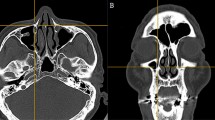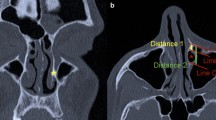Abstract
Background
The pre-lacrimal window approach (PLWA) is a promising technique in approaching lesions of the anterior wall and floor of the maxillary sinus. Simmen et al. previously reported that this approach is feasible in only 2/3 of their patients. This percentage appears to be lower than that of our local (mainly Chinese) population based on our clinical experience. Our study aims to measure the distance between the anterior maxillary wall and lacrimal duct in ethnic Chinese. A higher incidence of sphenoid–ethmoidal cells has been reported in Orientals. We postulate that there is also a higher incidence of wider pre-lacrimal recesses in Orientals thus making the PLWA more feasible to perform in Orientals.
Methods
100 consecutive sinus CT scans of adult patients with various rhinologic diseases that did not distort the bony anatomy of the maxilla were reviewed (2 sides each). The distance between the anterior maxillary wall and the anterior border of the lacrimal duct was measured in 200 sides. We have adopted the methodology of measurements previously published by Simmen et al. This is so that we could compare between Oriental and Occidental paranasal sinuses.
Results
A distance of more than 7 mm was found in 39.5% of our subjects and a distance of > 3–7 mm was seen in 53.5%. In 6.5% of our subjects we found a prelacrimal recess < 3 mm.
Conclusion
The PLWA could have been performed without removal of the bony lacrimal canal in 39.5% of our subjects ( > 7 mm). Good access to the anterior maxilla wall could also have been possible for 53.5% with sub-periosteal removal of the bony lacrimal canal and medial maxillary wall. Thus, the PLWA would have been feasible for 93% of our subjects. These percentages are significantly higher than Simmen’s study of 68.5% in an Occidental population.






Similar content being viewed by others
References
Robey A, O’Brien EK, Leopold DA (2010) Assessing cur-rent technical limitations in the small-hole endoscopic approach to the maxillary sinus. Am J Rhinol Allergy 24:396–401
Defreitas J, Lucente FE (1988) The Caldwell–Luc procedure. Laryngoscope. 98:1297–1300
Zhou B, Han DM, Cui SJ et al (2007) Endoscopic nasal lateral wall dissection approach to maxillary sinus [inChinese]. Zhonghua Er Bi Yan Hou Tou Jing Wai KeZa Zhi 42:743–748
Zhou B, Han DM, Cui SJ et al (2013) Intranasal endoscopic prelacrimal recess approach to maxillary sinus. Chin Med J (Engl) 126:1276–1280
Morrissey DK, Wormald P, Psaltis AJ (2015) Prelacrimal approach to the maxillary sinus. Int Forum Allergy Rhinol 6:214–218
Simmen D, Veerasigamani N, Briner HR et al (2017) Anterior maxillary wall and lacrimal duct relationship—CT analysis for prelacrimal access to the maxillary sinus. Rhinology 55:170–174
Tan HK, Ong YK (2007) Sphenoid sinus: an anatomic and endoscopic study in Asian cadavers. Clin Anat 20(7):745–750
Thanaviratananich S, Chaisiwamongkol K, Kraitrakul S, Tangsawad W (2003) The prevalence of a posterior ethmoid cell in adult Thai cadavers. Ear Nose Throat J 82(3):200–204
Yu QQ et al (2018) Intranasal endoscopic prelacrimal recess approach for maxillary sinus inverted papilloma. Eur Arch Oto Rhino Laryngol 275:2297–2302
Lee JJ et al (2018) Comparison between endoscopic prelacrimal medial maxillectomy and caldwell-luc approach for benign maxillary sinus tumors. Clin Exp Otorhinolaryngol. https://doi.org/10.21053/ceo.2018.01165
Gao L, Zhou L, Dai Z et al (2017) The endoscopic prelacrimal recess approach to the pterygopalatine fossa and infratemporal fossa. J Craniofac Surg 28:1589–1593
Janssen AG, Mansour K, Bos JJ et al (2001) Diameter of the bony lacrimal canal: normal values and values related to nasolacrimal duct obstruction: assessment with CT. AJNR Am J Neuroradiol 22:845–850
Funding
This study did not receive any funding.
Author information
Authors and Affiliations
Contributions
JKS and PSXL contributed to the design of the study and wrote the paper. GWS, KA and JPN Goh collected and analyzed the data. PSXL performed the statistical analysis.
Corresponding author
Ethics declarations
Conflict of interest
None of the authors have conflict of interest to declare. There are no financial disclosures for the above authors.
Ethics approval
This study has been approved by the Hospital Doman Specific Review Board (DSRB) and approved as per hospital ethics protocol.
Informed consent
As this is a retrospective study, and the data used are non-identifiable, patient consent was not required as per institutional ethics protocol.
Additional information
Publisher's Note
Springer Nature remains neutral with regard to jurisdictional claims in published maps and institutional affiliations.
Rights and permissions
About this article
Cite this article
Lock, P.S.X., Siow, G.W., Karandikar, A. et al. Anterior maxillary wall and lacrimal duct relationship in Orientals: CT analysis for prelacrimal access to the maxillary sinus. Eur Arch Otorhinolaryngol 276, 2237–2241 (2019). https://doi.org/10.1007/s00405-019-05446-0
Received:
Accepted:
Published:
Issue Date:
DOI: https://doi.org/10.1007/s00405-019-05446-0




